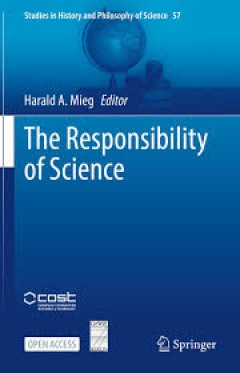Filter by

Enhancing Future Skills and Entrepreneurship : 3rd Indo-German Conference on …
This open access book presents the proceedings of the 3rd Indo-German Conference on Sustainability in Engineering held at Birla Institute of Technology and Science, Pilani, India, on September 16–17, 2019. Intended to foster the synergies between research and education, the conference is one of the joint activities of the BITS Pilani and TU Braunschweig conducted under the auspices of Indo-Ge…
- Edition
- -
- ISBN/ISSN
- 978-3-030-44248-4
- Collation
- IX, 292
- Series Title
- Sustainable Production, Life Cycle Engineering and Management (SPLCEM)
- Call Number
- -

Boreal Forests in the Face of Climate Change: Sustainable Management
Buku akses terbuka ini mengeksplorasi kerangka konseptual baru untuk pengelolaan hutan boreal yang berkelanjutan dalam menghadapi perubahan iklim. Hutan boreal adalah bioma terestrial terbesar kedua di Bumi dan mencakup sabuk seluas 14 juta km2, yang mewakili sekitar 25% dari wilayah hutan Bumi. Dua pertiga dari bioma hutan ini dikelola dan memasok 37% dari produksi kayu global. Hutan-hutan ini…
- Edition
- 1
- ISBN/ISSN
- 978-3-031-15988-6
- Collation
- 1 online resource ( XLIX, 837 Pages)
- Series Title
- Kemajuan dalam Penelitian Perubahan Global
- Call Number
- 634.92028 GIR b

The Responsibility of Science
Buku akses terbuka ini memberikan gambaran umum tentang berbagai isu tanggung jawab ilmiah. Volume ini terdiri dari tiga jenis kontribusi: pertama, analisis tanggung jawab sains; kedua, analisis kondisi struktural untuk sains dan tanggung jawabnya; dan ketiga, versi normatif tanggung jawab ilmiah. Pertanyaan dan masalah yang ditangani meliputi sains sebagai sebuah profesi, ambivalensi penelitia…
- Edition
- 1
- ISBN/ISSN
- 978-3-030-91597-1
- Collation
- 1 online resource ( Pages)
- Series Title
- Studi Sejarah dan Filsafat Sains
- Call Number
- 174.95 MIE r

Physiology, Psychoacoustics and Cognition in Normal and Impaired Hearing
Buku ini merupakan Prosiding Simposium Internasional Pendengaran (ISH) ke-17, yang diselenggarakan pada tanggal 15-19 Juni 2015 di Groningen, Belanda. Pertemuan ini melanjutkan tradisi konferensi yang telah dimulai sejak tahun 1969 dan telah diadakan setiap 3 tahun sekali. Ini adalah pertemuan ISH kedua yang berlangsung di Groningen. Penekanan dari seri ISH secara tradisional adalah menyatukan …
- Edition
- 1
- ISBN/ISSN
- 978-3-319-25474-6
- Collation
- 1 online resource ( Pages)
- Series Title
- Kemajuan dalam Kedokteran Eksperimental dan Biologi (AEMB)
- Call Number
- 616.855 DIJ p

Education and Skills for Inclusive Growth, Green Jobs and the Greening of Eco…
Buku ini menyajikan tinjauan umum dari temuan penelitian utama dan studi kasus mengenai pendidikan dan keterampilan untuk pertumbuhan inklusif, pekerjaan hijau dan penghijauan ekonomi. Berfokus pada India, india, Sri Lanka dan Vietnam, buku ini membahas tanggapan pemerintah dan sektor bisnis terhadap isu-isu ini dan bagaimana sistem dan lembaga Pendidikan dan Pelatihan Teknis dan Kejuruan (TVET…
- Edition
- 1
- ISBN/ISSN
- 978-981-10-6559-0
- Collation
- 1 online resource ( Pages)
- Series Title
- -
- Call Number
- 374.012338 LEA e

Global Perspectives on Recognising Non-formal and Informal Learning: Why Reco…
Buku ini membahas relevansi pengakuan dan validasi pendidikan dan pelatihan pembelajaran nonformal dan informal, tempat kerja, dan masyarakat. Di semakin banyak negara, buku ini berada di puncak agenda kebijakan dan penelitian yang menempati peringkat teratas di antara berbagai cara yang mungkin untuk mengatasi kurangnya kualifikasi akademik dan kejuruan yang relevan dan untuk mempromosikan pen…
- Edition
- 1
- ISBN/ISSN
- 978-3-319-15278-3
- Collation
- 1 online resource ( XIX, 220 Pages)
- Series Title
- Technical and Vocational Education and Training: Issues, Concerns and Prospects
- Call Number
- 374.12 SIN g

Skills Development for Inclusive and Sustainable Growth in Developing Asia-Pa…
Berfokus pada kawasan Asia-Pasifik, yang dalam beberapa tahun terakhir telah menjadi mesin pertumbuhan ekonomi global, volume ini mensurvei tren dan prospek dalam pendidikan dan pelatihan teknis dan kejuruan (TVET) dengan referensi khusus untuk mencapai pertumbuhan inklusif dan penghijauan ekonomi. Yang mendasari meningkatnya tekanan untuk model baru penyediaan TVET adalah laju perubahan teknol…
- Edition
- 1
- ISBN/ISSN
- 978-94-007-5937-4
- Collation
- 1 online resource ( XVI, 384 Pages)
- Series Title
- Technical and Vocational Education and Training: Issues, Concerns and Prospects
- Call Number
- 374.012 LEA s

Classification and Data Science in the Digital Age
Kontribusi yang dikumpulkan dalam buku akses terbuka ini berfokus pada metode modern untuk ilmu data dan klasifikasi serta menyajikan serangkaian aplikasi di dunia nyata. Banyak topik penelitian yang dibahas, mulai dari inferensi dan pemodelan statistik hingga pengelompokan dan reduksi dimensi, dari analisis data fungsional hingga analisis deret waktu, dan analisis jaringan. Aplikasi tersebut m…
- Edition
- 1
- ISBN/ISSN
- 978-3-031-09034-9
- Collation
- 1 online resource ( XIV, 416 Pages)
- Series Title
- Studies in Classification, Data Analysis, and Knowledge Organization
- Call Number
- 025.6 BRI c

Multifunctional Ceramic Filter Systems for Metal Melt Filtration: Towards Zer…
Buku akses terbuka ini mencakup teknik dan material baru untuk menghilangkan inklusi dalam lelehan logam, yang menghasilkan peningkatan signifikan pada kemurnian, kualitas, dan sifat material dari produk logam cor. Buku ini membahas generasi baru material filter cerdas dan sistem filter dengan permukaan fungsional untuk menghilangkan inklusi padat dan cair seperti produk deoksidasi, sulfida, da…
- Edition
- 1
- ISBN/ISSN
- 978-3-031-40930-1
- Collation
- 1 online resource ( Pages)
- Series Title
- Springer Series in Materials Science
- Call Number
- 671.25 ANE m

Anticipating and Preparing for Emerging Skills and Jobs: Key Issues, Concerns…
Buku akses terbuka ini menganalisis faktor pendorong utama yang memengaruhi evolusi dramatis pekerjaan di Asia dan Pasifik serta mengidentifikasi implikasinya terhadap pendidikan dan pelatihan di kawasan tersebut. Buku ini juga menilai bagaimana filosofi, kurikulum, dan pedagogi pendidikan dan pelatihan dapat dibentuk kembali untuk menghasilkan pekerja dengan keterampilan yang dibutuhkan guna m…
- Edition
- 1
- ISBN/ISSN
- 978-981-15-7018-6
- Collation
- -
- Series Title
- Education in the Asia-Pacific Region: Issues, Concerns and Prospects
- Call Number
- 331.259 PAN a
 Computer Science, Information & General Works
Computer Science, Information & General Works  Philosophy & Psychology
Philosophy & Psychology  Religion
Religion  Social Sciences
Social Sciences  Language
Language  Pure Science
Pure Science  Applied Sciences
Applied Sciences  Art & Recreation
Art & Recreation  Literature
Literature  History & Geography
History & Geography